Bachman Farish
Following their take-over of the former Graham farish range Bachman have introduced a large number of entirely new models suitable for all periods from the pre-grouping to the present day. They have retained a number of the original models and have also revamped the mechanism used on the former Farish diesel locomotives. I gather they will be introducing a range of steam locomotives on completely new chassis over time. This is undoubtely one of the most interesting and encouraging developments in the scale since the early 1980s. Seveal of the former Graham Farish models are not currently in production, however some of these are used (as of September 2006) in the train set packs, including the LBSC brake van and pressed steel mineral wagon. For details of the former Graham Farish range please see the separate entry.
Pre-Nationalisation
5 Plank Steel Floor
5 Plank Wooden Floor
8 Plank End Door Wagon
8 Plank Wagon
7 Plank Wagon with Coke Rail
This model represents an RCH standard wagon with end door built with coke extension rails (differing in detail from the Peco type of rails). The example shown has a home made load made of the grey/black foam nti static sheeting used to pack electrical components. This is free (ask at your local computer repair shop) and looks very like coke.

7 plank end-door wagon
A useful adjunct the the Peco 7 plank wagon as this model has the end door.
Pre nationalisation 4 wheel tank wagon (large and small filler dome types)
A wecome addition to the available tank wagons, one variant on these models features the over-the-tank wire rope stops (not formerly seen on a model tank wagon). Three types are available, one with a large filler dome and over-the tank strops, another with a smaller exposed filler cap and a third with platforms and ladders (nice mouldings on the ladders).

30 Ton Bogie Bolster Wagon
FISH VAN - A Great Northern Railway `fitted' fish van design
which passed to the LNER at grouping. Incidentally the LNER moved the greater
part of the home waters catch of fish, hence rakes of such wagons would be
appropriate. As a fitted wagon these might have been seen attached to passenger
trains up to the Second World War.
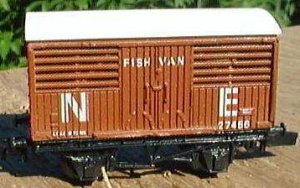
CATTLE WAGON - A Midland Railway standard design perpetuated by
the LMS. To add a little interest to the roof one can add strips of plasticard
or postcard to form the thin wooden strips used to prevent the nails holding
the canvas roof sheet from penetrating and possibly injuring the cattle. Note
the ends are standard MR van ends and so substitute sides can be used to
produce a selection of MR/LMS vans. The photo shows an example repainted as an MR van.
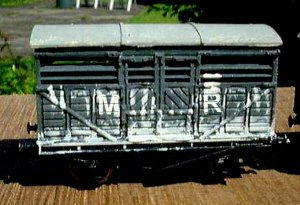
One sometimes sees pictures of cattle wagons with white interiors and white stains on their sides caused by `lime washing' the insides of the wagons as a way of disinfecting them. The interior of these wagons should be all white and the liquid leaked out between the planks as well as through the built-in openings. There would be patches of white all over the body but mainly where there were gaps such as the openings at the bottom and around the open upper sides. This practice was banned in the 1920's, so the stains should not appear on Big Four or British Railways stock.
BOGIE OPEN - This represents the 50 ton bogie ammonium sulphate
wagons, about a hundred of which were built by the LNER to carry sacks of the sulphate, in which traffic they were sheeted. These
were amongst the largest open wagons built for British rails up until the late
1960's. The BR livery is correct but Graham Farish used to offer this wagon in
LNER red oxide livery which is incorrect, these were `unfitted' wagons and so
should have a grey body (the Roche drawing on which the model is based is
incorrect). The photo shows the original Graham Farish model, that has been fitted with Mike Bryant wheels.
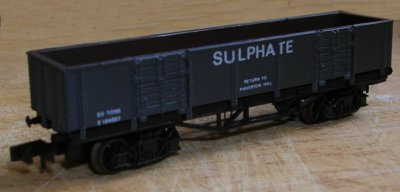
These wagons were subsequently used for a weekly train moving rubbish out of London in the later 1960s and early 1970s (when they were replaced by redundant 16 ton mineral wagons). Both types were unsheeted when in this traffic and I gather the smell was a bit strong. The London terminal was located where the current Arsenal football ground is today. Kevin Allsop on the newsgroup uk.railway was able to advise The depot was Ashburton Grove. There was an 08 outstationed there, manned by Kings Cross drivers, at least until 1980. A new Waste Transfer Depot was built there in the late 1980s, with waste removed by road. As part of the Arsenal stadium redevelopment a replacement depot at
Holloway had to be provided. This is supposed to have provision for a possible future return of the traffic to rail.
On the same thread Peter Lawrence advised that- The destination was Blackbridge tip, near Wheathampstead, now full up
but easily recognisable by walkers along the footpath on the branch
line formation. The Black Bridge itself has been removed though.
Incidentally, Wheathampstead station yard had a dung siding once used
for wagons of the stuff supplied by London Zoo to local farmers.
Apparently this also was sent via Ashburton Grove but I don't know how
it got there from the zoo!
BOGIE VAN Not currently in production - A North Eastern Railway van, passed into the LNER in
1923. Some seen until the 1970's possibly the 1980's in departmental service on
BR. The underframe with its heavy trussing is that used for the 50 ton bogie
sulphate wagon but this van had little in the way of under trussing. Removal of
the brake handles and cutting away the heavy bars whilst leaving the outer two verticals and running thread across these produces a reasonable effect. Note the doors and roof hatches which may be used as a
guide for modifying the Peco Reefer van to an NER 10t van. The photo shows the original Graham Farish model fitted with Mike Bryant wheels.
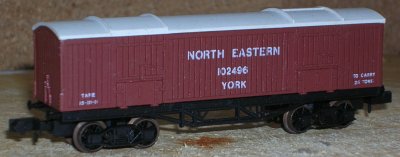
The Lancashire and Yorkshire Railway and GWR also operated large bogie vans, the GWR type can be made from a couple of 'iron mink' kits with a new roof. The L&Y type can be built using Peco insulated van ends with new sides and roof or it can be modified from the Farish van by replacing the sides, adding the distinctive inverted V end braking and changing the roof doors to the L&Y cloth-and-bars type. For both a home-made chassis of 30 thou card sandwiched between two strips of 10 thou card with trussing from wire is preferable to using the Farish chassis.
BR era (Vacuum brake)
BR brake van
Based on the LNER standard brake van these remained in service into the 1990s although they were not used on all air-brake trains from the mid 1980s.
Early BR slope-sided 16ton end-door mineral wagon
Based on the pre-war Charles Roberts (a wagon building firm) private owner 15 ton all-steel wagon a large number of 16 ton examples were produced for the wartime Ministry of Supply, a useful model as they remained in service into the 1970s. All were unfitted.

BR 16ton end-door mineral wagon
A standard BR design, based on wartime Ministry of Supply designs and built in many thousands these were characteristic of the post war era. Some vacuum braked examples were produced but the vast majority were unfitted. They remained in service into the 1980s.

BR 27ton stone tippler wagon wagon
Essentially a doorless version of the BR 16 tonner, sprung for heavier loads and used for stone such as granite, limestone and chalk. Produced in vacuum braked and unfitted versions, although most fell from use with the end of British ore mining in the later 1970s a few remained in use on dedicated flows into the later 1980s.
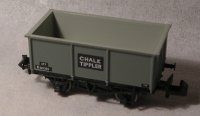
12 Ton Ventilated Van Planked Sides
This is the BR standard design dating from the early 1950s and in use into the 1970s.
10 Ton Insulated Van Planked Sides
This is the BR standard design dating from the early 1950s and in use into the 1970s.
12 Ton Ventilated Van Plywood Body
This is the BR standard design dating from the early 1950s and in use into the 1970s.
PRESFLO 20 TON HOPPER -Introduced by BR in 1954, originally for
cement traffic they were also used for other bulk powders, such as salt, slate
powder, fullers earth, and alumina. This wagon was also used by BR from about 1966 to carry
fly ash traffic from power stations and these fly ash wagons were then changed to
air brakes. The name Presflo refers to the 'air fluidisation' system built into
these wagons. The system works by blowing in air to `fluidise' the powder which
flows out of the discharge pipe in the air-stream. They were designed to be
emptied using a small portable air compressor and so might be seen in even a
small station goods yard where they would be discharged into lorries for
delivery. When new they were often seen in colourful PO liveries, although many
were in standard BR bauxite, lettering details will be found in the section on
post-nationalisation wagon development. The photo shows one of the original Graham Farish models, with their rather shiny wheelsets, in 'fly ash' livery.
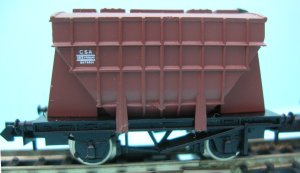
The fly ash trains were a block working in BR bauxite livery, now
available from Graham Farish (they were clean as they were washed down at the
power station after filling with the ash). The last two BR owned cement
carrying examples were condemned in 1987/88, but Blue Circle still owned well
over one hundred of these wagons at that time. The company logo was removed
from the private owner stock in 1985 and after that they ran in a livery of
plain pale grey with either white or black lettering. The BR fly ash wagons
were reported out of use and in storage in the mid 1990's. (See also Lima
Prestwin)
100t TANKER - These high-speed high-capacity wagons first
appeared on the railways in 1966, some two years prior to the blue corporate
livery. The PO liveries were phased out in about 1974 as being too expensive to
maintain. By the mid 1980s the tanks were usually grey with red sub-chassis above the bogies for class A liquids (eg petrol) or
black for class B liquids (eg fuel oil) and were not cleaned very often.
The 90 ton LPG tank version can be modelled by removing the end ladders and top walkways, leaving a slot along the top of the tank. The slot can be covered with a strip of 10 thou card extending down almost to the centreline to represent a 'sun shield' and the filling hatches can be represented with 10x10 thou strip and scraps of 10 thou card.
These wagons can run alongside the Peco
fifteen foot wheelbase LPG wagons.
Interestingly tank wagons to a basically similar general design were
built in the 1950's or possibly even the late 1940's, although the tanks used
were only about half the capacity of the 100 tonners. The diameter of the
Graham Farish tank is a shade on the large side for these older wagons but if you remove the ladders
and catwalks and shorten the wagon by cutting a section from the centre you get
something not unlike one of these earlier wagons. You would have to fill in the
slot along the top and add new ladders and filling domes and apply your own
livery. There is an illustration in Don Rowlands book on early BR Freight
Wagons which shows one of these early tanks, with a 40 ton payload, used by a
specialist haulier for liquid latex traffic out of Liverpool docks. The dimensions and details shown on the drawing are courtesy of contributors to the uk.rec.models.rail newsgroup.
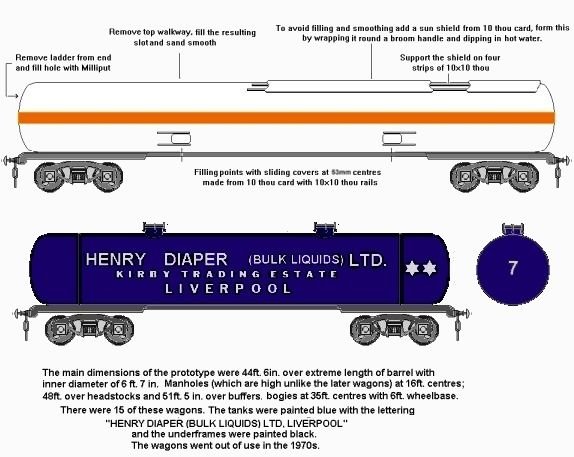
BR era (Air brake)
40 Ton Sealion YGB Bogie Hopper
This is a large ballast wagon used by the engineers.
CONTAINER FLAT - A standard BR Freightliner wagon, introduced in
1964. The bogies are a little on the heavy side for this wagon, being (I am
informed) better suited to the bogie tanker, for which they were originally
produced. The `Freightliner' liveries offered are the two most recent of four,
but I am unsure of the exact periods they cover. Alternative transfers are
available from specialist suppliers, and Graham Farish produce unpainted
`boxes'. One possible mod to this model is to fit a wooden (scribed card) floor
with raised ends and drop-flaps to cover the buffers. Modified container flats
of this type are used for carrying commercial vehicles (up to at least 1987).
See also the Lima Freightliner wagon entry.
46 Ton GLW HAA MGR Hopper
A useful model of a Merry-Go-Round 32.5 ton coal hopper. These were originally coded HOP 32 AB, and introduced in 1964, over 10,000 being produced. The liveries at the time of writing are the post 1974 TOPS and the 'sector era' coal sector markings. The HAA was developed for supplying regular customers such as power stations and it is fitted with automatic discharge gear. Top speed loaded is 45 mph and empty 50 mph. In the 1990s some of these wagons were revamped with improved suspension and air brakes to enable speeds of up to 60 mph and re-classified as HFA. Some routes have sufficient clearance to allow side and ends extensions to be fitted to the hopper to increase their capacity and there was a kit available (to suit the older Minitrix wagon) but at the time of writing I am unable to find any advertisements for this. The Peco range includes coal loads and 'hoods' for these wagons, which should fit but I have not tried them myself. In the early years a number of these wagons were built as covered hoppers with a solid roof with roof top hatches fitted and these remained in use, coded CBA, at least into the late 1990s carrying limestone. At the time of writing I am unaware of any RTR models or conversion kits for this variant. Some of the open wagons were also converted to carry china clay, re-coded CDA they entered service in January 1988. The CDA has a motorised canvass cover or 'hood' and a conversion kit to suit the Minitrix wagon was available from Kingdom Kits (available via N Gauge Enterprises in Huntingdon) which should fit the Farish model (Peco have released a ready to run model of the CDA).
HFA Hopper Wagon with Dust Cover
These are re-sprung HAA hoppers modified in the mid 1990s and capable speeds of up to 60mph.
HEA 46 Ton GLW domestic coal opper
The HEA is a re-sprung HBA hopper wagon, introduced to supply domestic coal dumps in the mid 1970s, no automatic discharge gear being fitted. They are air braked and originally they had a through pipe for working with older vacuum braked stock. The model is at the time of writing available in BR 'coal sector' livery and post privatisation EWS livery. In the BR era some HEAs carried a `St Andrews Cross' (a blue rectangle with a white X, about a foot square or in the form of an oblong flag about eighteen inches long by ten inches high) on the side to indicate that were to be returned to Scottish destinations. Following the reduction in coal traffic after the 1984 miners strike some have been further modified to carry minerals and `fragmented scrap metal' (these latter being coded HSA).
HSA 46 Ton GLW scrap metal hopper
The HSA is a HEA hopper wagon, introduced to carry `fragmented scrap metal' in the mid 1980s (following the 1984 miners strike which reduced the demand for HEAs).
46 Ton GLW CEA Hopper
The CEA is an HEA hopper wagon fitted with a powered retractable canvass roof, I believe these were introduced in the early 1990s (possibly the later 1980s). The model is, at the time of writing, available in late 1980s BR black with orange ends and in post privatisation EWS livery.
OAB/OAA open wagon. Introduced in 1971 this was the first of the
standard wagons on the new air-braked 20 foot 9 inch wheel base chassis and has
steel ends with wooden drop sides. OAB is not a TOPS code but an abbreviation
for Open AB, the original code for these air braked vehicles. OAA is the TOPS
code for the wagon. Available in both liveries. It is worth noting that these
were supplied with a plastic tarpaulin, usually pale olive green in colour,
marked in white letters about 6 inches high: TO BE RETAINED WITH AB OPEN
WAGONS. These wagons are still in service, some are used for palletised roof
tile traffic and carry the Redland livery.
VAB/VBA sliding door van introduced in about 1968 (originally coded COV AB - The model is produced in the same two
liveries (post 1964 bauxite and post 1980 Railfreight) as the open wagon
described above. VAB is an abbreviation of the original Van AB code but I
believe the code should be Cov AB as I understand Van AB was used as the code
for some of the Vanwide ten foot wheelbase vans which had been fitted with air
brakes. I am not absolutely certain of the pre-tops codes but VBA is the
correct TOPS code for the vehicle (it has no end ventilator, adding one produces either a VAB fitted with a pipe to run with vacuum braked stock or VAA un-piped van).
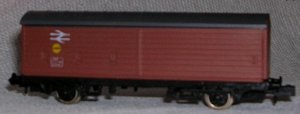
46 Ton VGA van
The VGA is a 42 foot long, sliding-wall van with a wheelbase of 29 feet 6 inches. Based on a German built design originally produced for Ford (UK) in about 1981 these have proved to be a very successful vehicles. The body had heavily ribbed ends and the roof forms only a narrow strip along the centre line. Each side consisted of two sliding doors made of light alloy and the upper part was bent inwards, forming part of the roof. This arrangement allowed loads to be craned into the van and provides easier access for fork lift trucks. To increase the carrying capacity the section between the wheels was dropped to form a well and the actual capacity of the vans was some 75 cubic metres with a 25 ton payload. Some VGA vans were later fitted with modified bearings and coded VKA. The model is at the time of writing available in EWS livery.
PCA (cylindrical tank) This represents one of the modern
air-fluidised power carrying vehicles, built for operation by private owners
and wagon leasing firms, introduced in the mid 1960s. They are used for cement,
grain and various powdery chemicals. Blue circle (and several other cement
companies) discontinued their colourful liveries in the mid 1980s and most of
these wagons have run since in a plain livery of light grey tank on a black
chassis, usually with simple TOPS lettering in white. The company liveries have
made occasional reappearances however and I understand that the liveries on
offer are all appropriate.
PCA (depressed centre tank) This represents a PO design gravity
discharge power carrying wagon which appeared in the mid to late 1960s and
became the most popular design for cement traffic. Later examples were fitted for air-fluidisation. The comments on livery for
the cylindrical PCA tank wagon above also apply to this design. In the early
and mid 1990's these wagons were seen passing through my local station several
times a week (carrying chemical powders) and featured a livery of a plain if
rather dirty white or possibly light grey tank on a black chassis as discussed
for the cement wagon above. In the 1970's a bogie cement wagon carrying a pair of
depressed centre tanks (similar to those on the Graham Farish wagon) and
equipped for either gravity or air fluidised discharge were built for Blue Circle (these
remained in service at least into the early 1990s). Subsequent builds of the
single tank four wheelers also had the air system built in as an option. The
bogie types were also used for china clay traffic in a rather fetching bare
metal 'silver' tank livery.
PGA Open Hopper These are the successful 50-ton GLW PO hopper
wagons designed and built by Procor for road-stone traffic in the mid 1970's.
With the cutback in road stone useage the wagons have been pressed into service
on a number of duties (in 1998 rakes of these wagons replaced the old ICI
vacuum braked 23 ton bogie hoppers on the Northwich-Tunstead limestone run, problems with dust blowing off and high vibration from the non-welded rail saw them replaced by large bogie types a couple of years later).
PGA Closed Hopper
This is the roofed version of the Procor 50-ton hopper wagon, some are
used by 'stone' firms and the model serves well enough for sand or salt wagons,
the vehicles used for these commodities are broadly similar in design but with
differences in the external ribbing and the design of the roof. Bernard Taylor
of Taylor Plastic Models has released a detailing kit for use with the British
Industrial Sand wagon. The sand wagons are used for chemically treated and
purified sand used in glass and ceramic making. Broadly similar hoppers are
also used for a number of granular or powdery chemicals.
MEA 46 Tonne GLW Open Mineral Wagon
These door-less open wagons with a heavily ribbed body are used for everything from coal to aggrigates, they are typically unloaded using a crane fitted with a grab.
POA 46 Tonne GLW Box Mineral Wagon
The original POA was a ribbed body open steel wagon for scrap metal traffic, introduced by Railease in 1978. Later models had an additional strengthening beam along the upper sides. I have not yet seen the Bachman Farish model so cannot comment further.
MFA 24 Tonne Open Box Mineral Wagon
These are simple half-height mineral wagons with a heavily ribbed body, often used for transporting ballast (emptied using a tracked or wheeled crane with a grab)
Post Privatisation
102 Ton GLW Bulk Bogie Coal Hopper
This is a post privatisation high capacity coal hopper, available at the time of writing in EWS livery (I believe Freightliner operates similar wagons in their 'heavy haul' business).
100 Tonne GLW HHA Bogie Hopper Wagon
104 Tonne GLW BYA Steel Coil Carrier
These wagons have a distinctive three-section telescopic body made of ribbed steel curved over to an inverted U shape at the top, introduced for EWS steel traffic.
104 Tonne GLW BRA Steel Strip Carrier
102 Tonne GLW HTA Bulk Coal Hopper
Brakevans
BR - A standard BR brake van, based on the LNER standard design.
GWR - Due for re-release in 2006 - A standard GWR `Toad', introduced in about 1912. Should be
a 16 foot wheel base but looks well enough, the difference is not really
noticeable. BR also built further examples of this design but they were
generally confined to the Western Region area, and were in fact marked ``NOT IN
COMMON USE''. The BR liveried version is of an unfitted type
SR/LMS - Not currently in production - The SR version serves quite well an ex LBSCR design,
which saw service up to the early BR period. The LMS version requires some
modification, principally the fitting of `duckets' over the side windows
(similar to those on the Peco brake van) to represent an early 1930's design.
____________________________________________
^
Go to top of page











